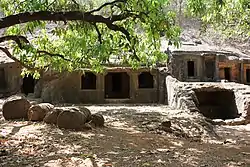Panhalakaji Caves
Panhalakaji Caves are situated in the Ratnagiri district of Maharashtra state, about 160 km south of Mumbai. This cave complex has around 30 Buddhist and Hindu caves.[1] The Hinayana sect began carving caves in 3rd century AD, beginning with the stupa in the current Cave 5.[2] The caves have inscriptions in Brahmi and Devanagari script.[1] In the 10–11th century AD another Buddhist group, a Vajrayana sect, established cave 10 with their deities Akshobhya and Mahachandaroshana; and strengthened their practice in that region. Shiva and Ganpatya worshiping started at the site during Silahara rule.[2] There are total 29 caves out of which 28 are situated on the right bank of mou tain stream Kotjai.
| Panhalakaji Caves | |
|---|---|
 Panhalakaji Caves | |
  | |
| Coordinates | 17.645678°N 73.245072°E |
| Pilgrimage to |
| Buddha's Holy Sites |
|---|
 |
A list of important caves includes:[2]
- Cave 10 has and image of Maha-Chandraroshana. This deity is shown on the stupa which signifies the connection of Ratnagiri with ancient Buddhist sites of Orissa.
- Cave 14 has deities of Nath Pantha.
- Cave 19 has shivlinga in it. It has Hindu scriptures on its ceiling.
- Cave 29 was used by Nath Pantha and was renamed as Gaur Lena.
 Pillars
Pillars Frieze with elephants
Frieze with elephants Stone pillar
Stone pillar Stone carvings depicting various Mahasiddhas
Stone carvings depicting various Mahasiddhas Stone carvings
Stone carvings
How to reach
- By train: Nearest Rail station is Khed, Ratnagiri.[1]
- By road: Located on NH 4 highway near Dapoli.[1]
Further reading
Deshpande, Madhusudan Narhar (1986). The caves of Panhāle-Kājī (ancient Pranālaka): an art historical study of transition from Hinayana, Tantric Vajrayana to Nath Sampradāya (third to fourteenth century A.D.). New Delhi: Archaeological Survey of India. ASIN B0006EPMPS. OCLC 923371295. Retrieved 5 February 2021.
References
- ET Bureau (18 April 2013). "Quick getaway: Dapoli, Saharanpur, Nanjagud". Economic Times. Bennett, Coleman & Co. Ltd. Retrieved 10 November 2013.
- Mitra, Debala (1984). India Archaeology 1981-82 (PDF). New Delhi: Archaeological Survey of India, Government of India. pp. 97, 98. Archived from the original (PDF) on 26 November 2013. Retrieved 10 November 2013.